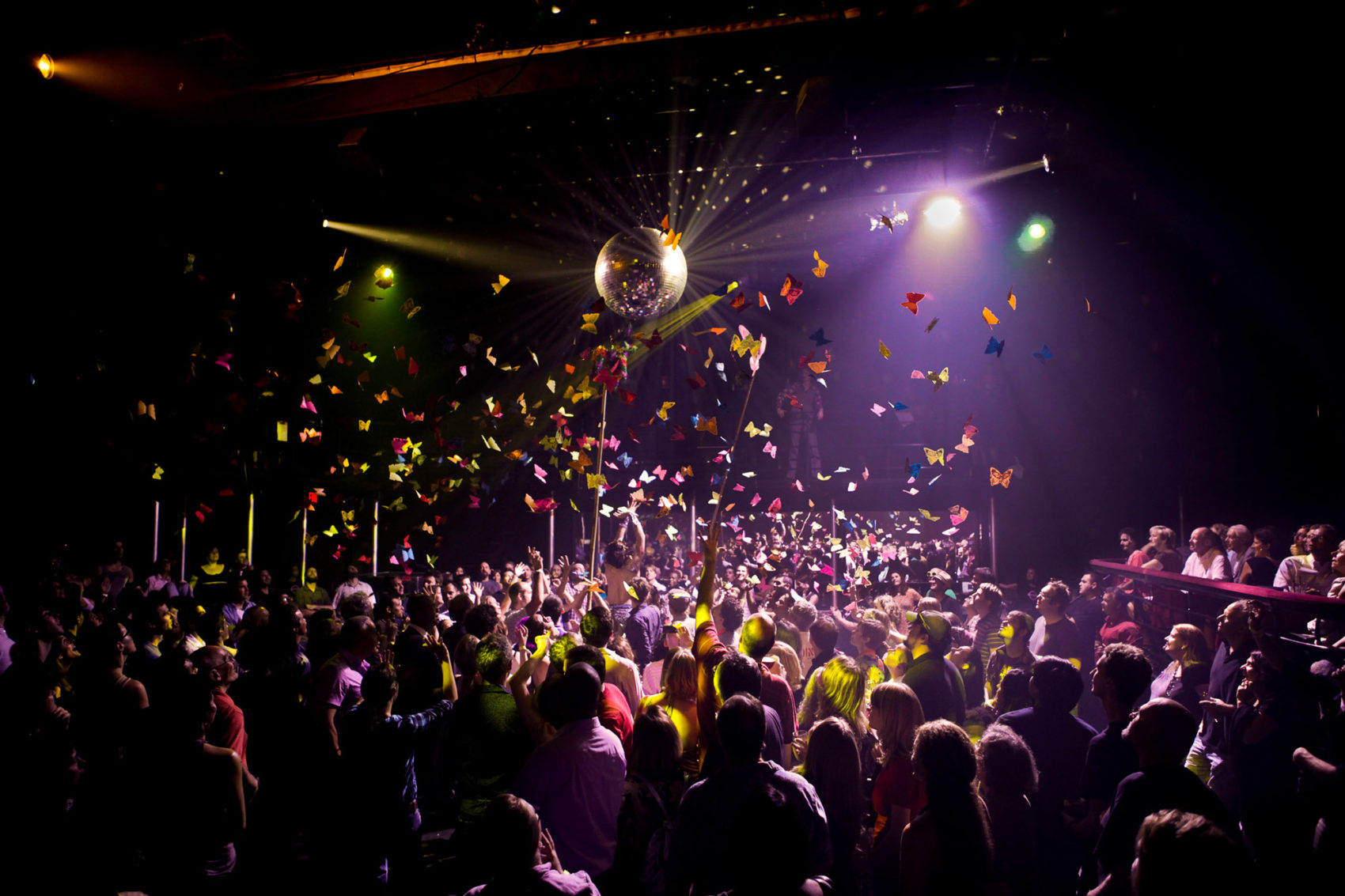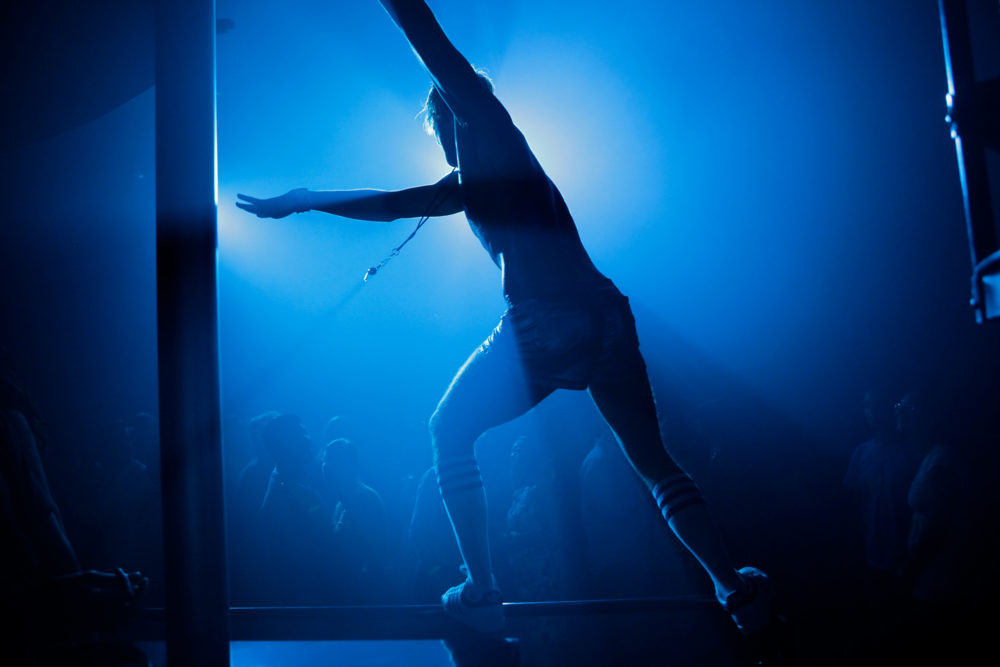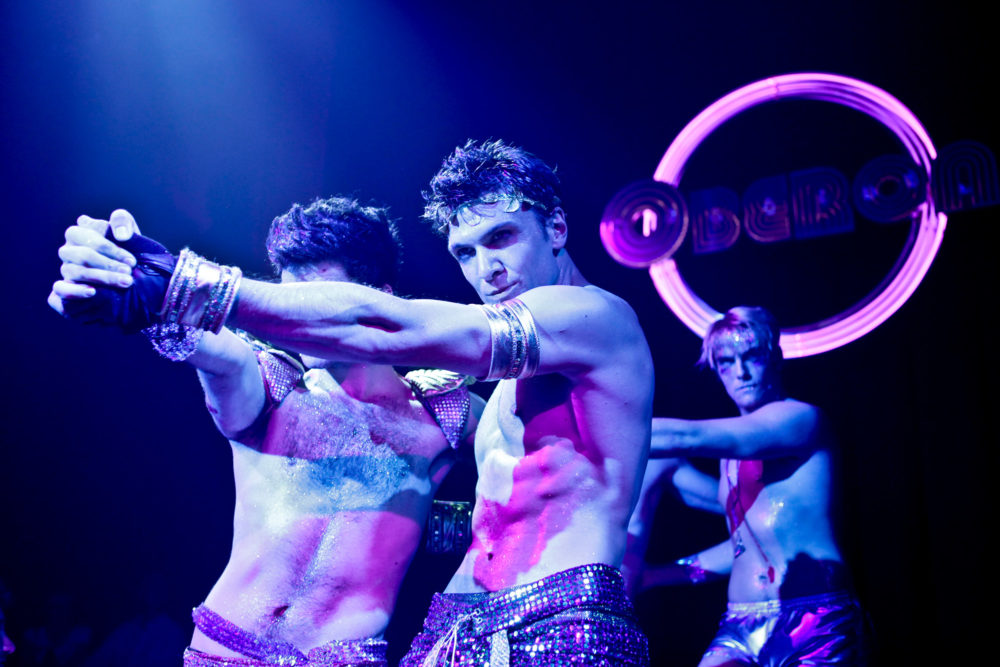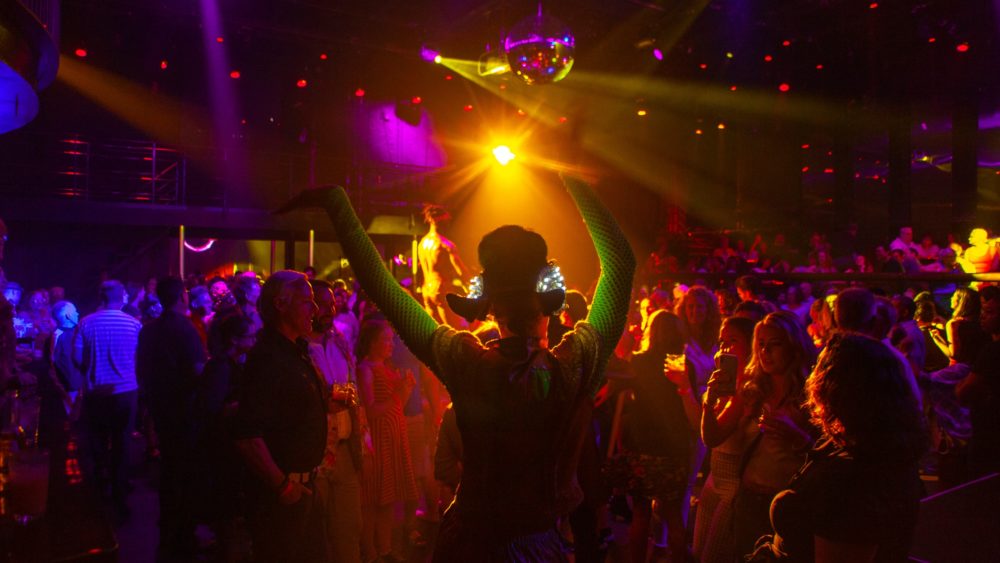Advertisement
Commentary
‘The Donkey Show,’ #MeToo And Me
Resume
I'll never forget the first time I saw "The Donkey Show." I was just out of college and about to start a job at OBERON, the Cambridge venue where the show ran on weekends. I was a little hazy on the details — my friend who got me the gig had made the place sound like some kind of debaucherous gay paradise, which sounded fun, but intimidating. Before my first shift, the bar manager told me to come check it out, just so I could see what I was getting myself into.
A line snaked down the sidewalk outside the club. A few of the actors mingled with the waiting crowd; there was a guy in roller skates and gold face paint, a muscley bouncer with his shirt half unbuttoned and a haughty-looking woman in little else besides thigh-high pleather boots and butterfly pasties. Inside, male go-go dancers gyrated beneath a massive disco ball, their lithe torsos so caked in body glitter they gave off a blue glow. A woman in a teal dress and silver heels shimmied up and beckoned me onto the dance floor. I shrank into a corner by the bar.
Over the course of the night, a disco-themed takeoff on Shakespeare's “A Midsummer Night’s Dream” unfolded. This was in 2010, when “The Donkey Show” ran most Friday nights and twice on Saturdays, and was always packed. Two bars were necessary to accommodate the crush of sweaty revelers clamoring for Red Bull vodkas and a pink concoction called the Tytania’s Kiss. There was a semi-secluded “VIP booth” in one dark corner of the club where people did unspeakable things. There was glitter everywhere: in the seams of the dance floor, on the bar, in the beer taps and probably in the plumbing. It settled on us like mist, working its way permanently into our scalps and the soles of our shoes, rendering us festive no matter how gloomy or hungover we felt.
A nostalgia trip lent dubious gravitas thanks to its association with the Bard, “The Donkey Show” set the subversive-yet-commercial tone for Paulus’ reign.
On Saturday, “The Donkey Show” will end a decade-long run at OBERON, the American Repertory Theater's second stage. The event marks the end of an era for both the A.R.T. and its artistic director Diane Paulus, who helped originate the show with her husband Randy Weiner in New York City in 1998. She revived the show in 2009 in her first season with the A.R.T. A nostalgia trip lent dubious gravitas thanks to its association with the Bard, “The Donkey Show” set the subversive-yet-commercial tone for Paulus’ reign. When it opened, I imagine it scandalized A.R.T.'s longtime subscribers, but it charmed the press. It also provided the blueprint for the theater-cum-bar that was OBERON, which, over the years, nurtured an increasingly eclectic array of fringe and local performance art.
The A.R.T.’s official reason for closing the show now — aside from 10 years being a nice round number — is that OBERON is simply in such high demand, both from independent producers and the A.R.T.’s own productions. But the show also ends, perhaps conveniently, in a moment when it is beginning to show its age. “The Donkey Show,” which is set in a Studio 54-esque nightclub, both satirizes and celebrates the era’s lascivious, drug-addled ethos, and the sexual predation that so often occurred in nightclub settings. In the midst of a cultural reckoning around sexual assault, audiences are far more likely to look askance at a production that deals so irreverently with these themes.

That first night, I lurked by the bar as the room filled up. But once the performance started, I found myself sucked into its slipstream. The play unfolded in and around the dance floor: on top of tables, on a catwalk above the bar, on shiny movable cubes that the dancers pushed around the room, even once in a while on the stage. It quickly became apparent that this was a very loose interpretation of “A Midsummer Night’s Dream.” Nary a word of Shakespeare was spoken; instead, the characters sang their feelings, to tunes like “We Are Family” and “Ring My Bell,” in a strange merging of karaoke and burlesque. Each of the main characters from the play had a disco-appropriate counterpart. Oberon, Shakespeare’s King of the Fairies, appeared as the owner of the nightclub, a mustachioed patriarch in a white suit and a permanent leer. His sidekick, formerly the impish sprite Puck, had transformed into a roller-skating drug dealer named Dr. Wheelgood. Titania, Queen of the Fairies, became Tytania, and was topless. The play’s starcrossed human lovers — Hermia, Lysander, Demetrius and Helena — were patrons at the club named Mia, Sander, Dimitri and Helen. Two Travolta-esque goofballs, both named Vinnie, stood in for Shakespeare’s donkey-headed purveyor of comic relief, Bottom. In this neon-tinged, “Saturday Night Fever”-dream, drugs were imbued with magic. Dimitri and Sander snorted cocaine and became obsessed with the same woman. In the show’s creepiest scene, Mr. Oberon drugged a sleeping Tytania and then steered her into the waiting arms (hooves?) of the two Vinnies, who had somehow transformed into a single donkey. A well-timed release of shiny silver confetti sent the audience into raptures. I was utterly entranced.
The show was pure camp — cartoonishly raunchy, slapstick and self-aware. And it felt strangely subversive, not just for the casual nudity, but for its queerness and its kink. The go-go dancers were airlifted directly out of a seedy ‘70s gay club. (These were the “fairies,” a cheeky reference to their Shakespearean counterparts, Titania’s supernatural servants.) At one point, Dr. Wheelgood, dressed in drag, brandished a black BDSM whip; later, he and the DJ shared a sweet boy-on-boy smooch. Most significantly, all of the male speaking parts — Mr. Oberon, the Vinnies, Dimitri and Sander — were played by women. With slicked-back hair and smarmy mustaches, they lampooned a masculinity that was desperately sleazy and laughably fragile, transforming Shakespeare’s comic tale of heterosexual silliness into a farce of a different sort.

Of course, the casting gambit also functioned to soften the play’s regressive sexual politics, which became harder to overlook as time went on. Consider the Mr. Oberon/Tytania plot: The club’s slimy proprietor spends most of the play attempting to bring his defiant paramour to heel, and in the end succeeds by coercing her into having sex with a donkey. The act is portrayed quite explicitly onstage, in a winking nod to the illicit (and likely apocryphal) Tijuana sex shows that provided the production with its title. The climactic (so to speak) scene was always played for shock value and laughs, but in the wake of the #MeToo movement it looks far more sinister. Maybe we didn’t have access to the language before. Maybe that’s why we couldn’t see it for what it really was — rape.
Over time, the show changed in response to shifting cultural mores and increased audience scrutiny. Until recently, the Vinnies, Italian-American characters who were usually played by white actors, wore Halloween-store Afro wigs, a choice that was confusing at best and racist at worst. (Now they wear greasy-looking mullets.) The drug use was toned down, too. Whereas before Mr. Oberon would administer a dose of some mind-altering potion to a sleeping Tytania, in later productions he just sprinkled her with a handful of silver confetti — a change that perhaps diminished the roofie analogy but didn't really solve the play’s central problem.
Which isn’t to say previous iterations of “The Donkey Show” lacked an awareness of the story’s politics — on the contrary, the production always made quite explicit the troubling gender dynamics at play in “A Midsummer Night’s Dream” and in nightclubs of the disco era. The Mia/Sander/Helen/Dimitri subplot essentially operates as a crash course in the rules of consent, as the men’s overtures to the two women become increasingly aggressive. To watch “The Donkey Show” is to watch women repeatedly draw firm boundaries — Mia literally tells Sander, “I said NO!” — and their pursuers repeatedly push past them, though ultimately, it is Mia and Helen who emerge triumphant, and the guys who look like jerks.
So, on the one hand, you had a plot that offered a plausibly feminist critique of ‘70s club culture and on the other a story that seemed to celebrate sexual assault.
So, on the one hand, you had a plot that offered a plausibly feminist critique of ‘70s club culture and on the other a story that seemed to celebrate sexual assault. As an audience member, you were rendered complicit in the whole disquieting enterprise. When Dr. Wheelgood exhorted us to cheer for Tytania’s impending debasement, we obliged. Several times throughout the show Helen pleaded for help as Sander stalked her. The audience just watched — after all, isn’t that what they were supposed to do?
When I went to see the show again this summer, I wondered if I hadn’t given Paulus and Weiner enough credit. All they really did, I realized, was lay bare the facts of Shakespeare’s comedy, which is basically the story of a megalomaniacal man bent on exerting control over his wife. Before, I assumed Paulus wanted us to dance in willful ignorance of the story’s disturbing implications. Now I wondered if the discomfort I was feeling was always the point. Needless to say, this time I didn’t feel much like dancing.

For the people who worked at “The Donkey Show,” life perpetually threatened to imitate art. This was especially true for the cast, who were partially naked and constantly dodging handsy audience members. One actor described to me having his shorts pulled off by a man who was apparently attempting to tuck a dollar bill into his waistband. In instances like this, the cast walked a delicate balance — they had to protect each other, but they weren’t supposed to break the spell.
And yet. The actors, the tech crew, the bar staff — we all loved “The Donkey Show,” even after watching it hundreds of times, even though we sort of hated it. For a decade, it provided a reliable training ground for young actors, many of them students at Boston Conservatory and Emerson College. Some cast members stayed on for years, despite the show’s paltry pay. (The A.R.T. would not provide numbers, but a former cast member remembers being paid $60 per show a few years ago.) It was like nothing else in theater, immersive and pleasantly destabilizing.
I can’t quite figure out if the nostalgia I have for “The Donkey Show” is because of it or in spite of it. As with anything, we make our own meaning. We decide which friendships to nurture and which stories to tell; we build our own mythologies. Over the seven years I worked at "The Donkey Show," the production came to seem tedious, even shallow, and its treatment of misogyny not so much witty as frivolous. Sometimes I wonder if it deserved any of the credit in my warm memories of that period. But there's no doubt it helped set the tone for a workplace that was big-hearted and irreverent, and that I loved. When I returned this summer, I was reminded how delightfully twisted "The Donkey Show" could be — and even, after all these years, a little magical. The next day, I was pleased to see a soft sheen of glitter still stuck stubbornly to my shoes.
This segment aired on September 3, 2019.
